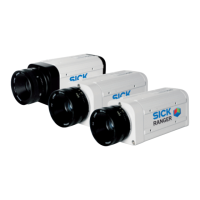Reference Manual Chapter 3
Ranger E/D
©SICK AG • Advanced Industrial Sensors • www.sick.com • All rights reserved 21
Mounting Rangers and Lightings
3.1.1 Occlusion
Occlusion occurs when there is no laser line for the Ranger to detect in the sensor image.
Occlusion will result in missing data for the affected points in the measurement result.
There are two types of occlusion:
Camera occlusion When the laser line is hidden from the camera by the object.
Laser occlusion When the laser cannot properly illuminate parts of the object.
Figure 3.4 – Different types of occlusion.
Adjusting the angles of the Ranger and the laser can reduce the effects of occlusion.
If adjusting the angle is not suitable or sufficient, occlusion can be avoided by using
multiple lasers illuminating the objects from different angles (laser occlusion) or by using
multiple cameras viewing the objects from different angels (camera occlusion).
3.1.2 Height Range and Resolution
The height range of the measurement is the ratio between the highest and the lowest
point that can be measured within a ROI. A large height range means that objects that vary
much in height can be measured.
The resolution is the smallest height variation that can be measured. High resolution
means that small variations can be measured. But a high resolution also means that the
height range will be smaller, compared with using a lower resolution in the same ROI.
In general, the height range and the resolution depend on the angle between the laser and
the Ranger. If the angle is very small, the location of the laser line will not vary much in the
sensor images even if the object varies a lot in height. This results in a large height range,
but low resolution.
On the other hand if the angle is large, even a small variation in height would be enough to
move the laser line some pixels up or down in the sensor image. This results in high reso-
lution, but small height range.
Figure 3.5 – The resolution in the measured range is higher if the angle between the laser
and the Ranger is large.
Laser occlusion
Camera occlusion
mall angle
Large angle
Measured range
in pixels
Measured range
in pixels
View from the Range
Sensor image

